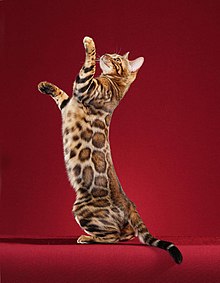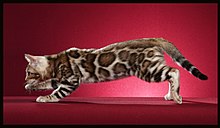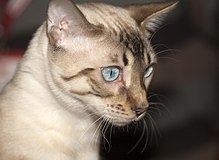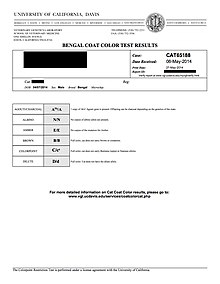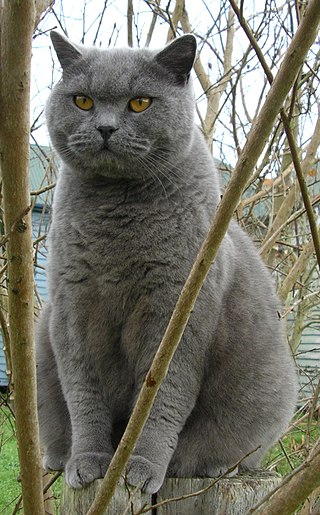
The British Shorthair is the pedigreed version of the traditional British domestic cat, with a distinctively stocky body, thick coat, and broad face. The most familiar colour variant is the "British Blue", with a solid grey-blue coat, pineapple eyes, and a medium-sized tail. The breed has also been developed in a wide range of other colours and patterns, including tabby and colourpoint.

The Sphynx cat also known as the Canadian Sphynx, is a breed of cat known for its lack of fur. Hairlessness in cats is a naturally occurring genetic mutation, and the Sphynx was developed through selective breeding of these animals, starting in the 1960s.

The Maine Coon is a large domesticated cat breed. It is one of the oldest natural breeds in North America. The breed originated in the U.S. state of Maine, where it is the official state cat.

The Scottish Fold is a distinctive breed of domestic cat characterised by a natural dominant gene mutation associated with osteochondrodysplasia. This genetic anomaly affects cartilage throughout the body, causing the ears to "fold", bending forward and down towards the front of the head. While this trait contributes to the breed's unique appearance, often described as "owl-like", it has negative effects on the cats' welfare.

The Munchkin is a breed of cat characterized by its very short legs, which are caused by genetic mutation. Compared to many other cat breeds, it is a relatively new breed, documented since 1940s and officially recognized in 1991. The Munchkin is considered to be the original breed of dwarf cat.
Hypertrophic cardiomyopathy is a condition in which muscle tissues of the heart become thickened without an obvious cause. The parts of the heart most commonly affected are the interventricular septum and the ventricles. This results in the heart being less able to pump blood effectively and also may cause electrical conduction problems. Specifically, within the bundle branches that conduct impulses through the interventricular septum and into the Purkinje fibers, as these are responsible for the depolarization of contractile cells of both ventricles.

The Ragdoll is a breed of cat with a distinct colorpoint coat and blue eyes. Its morphology is large and weighty, and it has a semi-long and silky soft coat. American breeder Ann Baker developed Ragdolls in the 1960s. They are best known for their docile, placid temperament and affectionate nature. The name 'Ragdoll' is derived from the tendency of individuals from the original breeding stock to go limp and relaxed when picked up. The breed is particularly popular in both the United Kingdom and the United States.

The Siberian is a centuries-old landrace of domestic cat in Russia, and recently developed as a formal breed with standards promulgated the world over since the late-1980s. Since 2006, the breed is recognised for registry and championship status with all major cat registries.
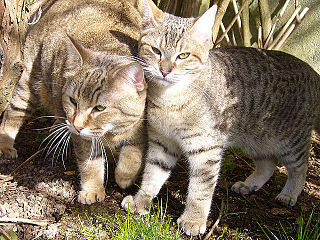
The Pixie-bob is a breed of domestic cat claimed to be the progeny of naturally occurring bobcat hybrids. However, DNA testing has failed to detect bobcat marker genes, and Pixie-bobs are considered wholly domestic for the purposes of ownership, cat fancy registration, and import and export. They were, however, selected and bred to look like American bobcats.

The Sokoke is natural breed of domestic cat, developed and standardised, beginning in the late 1970s, from the feral khadzonzo landrace of eastern, coastal Kenya. The Sokoke is recognized by four major cat pedigree registry organizations as a standardised cat breed. It is named after the Arabuko Sokoke National Forest, the environment from which the foundation stock was obtained, for breed development primarily in Denmark and the United States. The cat is long-legged, with short, coarse hair, and typically a tabby coat, though specific lineages have produced different appearances. Although once rumored to be a domestic × wildcat hybrid, genetic study has not borne out this belief. Another idea, that the variety is unusually ancient, remains unproven either way. The native population is closely related to an island-dwelling group, the Lamu cat, further north.

The Savannah is a breed of hybrid cat developed in the late 20th century from crossing a serval with a domestic cat. This hybridization typically produces large and lean offspring, with the serval's characteristic large ears and markedly brown-spotted coats. F1 and F2 male Savannahs can be very large, and in 2016 an F2 male attained a world record for tallest cat at 48.4 centimetres (19.1 in). Show-eligible F4–F5 cats range from 5.0 to 8.2 kilograms however, comparable in size to other large domestic cat breeds such as the Maine Coon or Norwegian Forest cat.
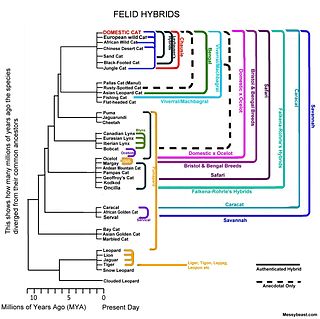
A felid hybrid is any of a number of hybrids between various species of the cat family, Felidae. This article deals with hybrids between the species of the subfamily Felinae.

The Serengeti is a hybrid breed of domestic cat, first developed by crossing a Bengal and an Oriental Shorthair. Created by biologist Karen Sausman of Kingsmark Cattery in California in 1994, the breed is still in the development stages, but the ultimate aim is to produce a cat that looks similar to a serval, without using any recent wild cat blood.

The toyger is a breed of domestic cat, the result of breeding domestic shorthaired tabbies to make them resemble a "toy tiger", as its striped coat is reminiscent of the tiger's. The breed's creator, Judy Sugden, has stated that the breed was developed in order to inspire people to care about the conservation of tigers in the wild. It was recognized for "registration only" by The International Cat Association in the early 2000s, and advanced through all requirements to be accepted as a full championship breed in 2012. There are about 20 breeders in the United States and another 15 or so in the rest of the world, as of 2012.

The Neva Masquerade is a breed or sub-breed of long-haired domestic cat, which originates in Russia. It is the sister breed or colourpoint variant of the Siberian cat, a centuries-old Russian landrace. The colourpoint markings are the result of a colourpoint gene originally found in Siamese cats. The Neva Masquerade is believed to be derived from crossing the Siberian cat with Asian colourpoint cats, such as the Siamese or Thai, or possibly cats related to those, such as the colourpointed Persian cats. Some cat registries may classify the Neva Masquerade as a colourpoint variety or sub-breed of the Siberian cat, while others consider it to be a separate sister breed. Regardless of its classification, all Neva Masquerade cats are selectively bred and pedigreed today in all major cat fancier and breeder organisations under the Siberian (Forest) cat or Neva Masquerade. This means that all Neva Masquerade cats are purebred cats with a formally registered ancestry.

A dwarf cat is a domestic cat with dwarfism due to rare genetic mutations causing a disproportionate feline body and significant health problems. Unlike undersized cats of normal proportions, dwarf cats suffer from the genetic mutations osteochondrodysplasia and achondroplasia. These genetic disorders of bone and cartilage are typically manifested as abnormal bone shape, poor growth or lack of growth, bowing of the limbs to the side – front legs are more likely to be affected, and spinal malformations.

The Minuet is a hybrid mix of Persian and Munchkin cat breeds. Categorized by The International Cat Association (TICA) as a domestic hybrid, "developed from a deliberate cross between two existing domestic breeds, incorporating characteristics of both parental breeds into the new mix." The Minuet cat is characterized by its short legs, as a result of the dwarfism-mutation derived from the Munchkin breed.
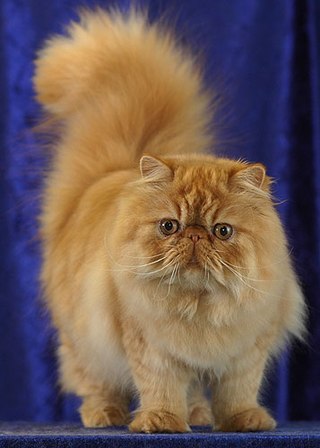
The Persian cat, also known as the Persian Longhair, is a long-haired breed of cat characterised by a round face and short muzzle. The first documented ancestors of Persian cats might have been imported into Italy from Khorasan as early as around 1620, however, this has not been proven. Instead, there is stronger evidence for a longhaired cat breed being exported from Afghanistan and Iran from the 19th century onwards. Widely recognised by the North-West European cat fancy since the 19th century, and after World War II by breeders from North America, Australia and New Zealand. Some cat fancier organisations' breed standards subsume the Himalayan and Exotic Shorthair as variants of this breed, while others generally treat them as separate breeds.

Jean Mill was an American cat breeder. Mill is best known as the founder of the Bengal cat breed: Mill successfully crossed the wild Asian leopard cat with a domestic cat, and then backcrossed the offspring through five generations to create the domestic Bengal. Mill made contributions to two other cat breeds: the Himalayan and the standardized version of the Egyptian Mau. Mill and her first husband, Robert Sugden, were involved in a precedent-setting case about the United States government's power to monitor short wave radio communications. She also authored two books on Bengal cats.
